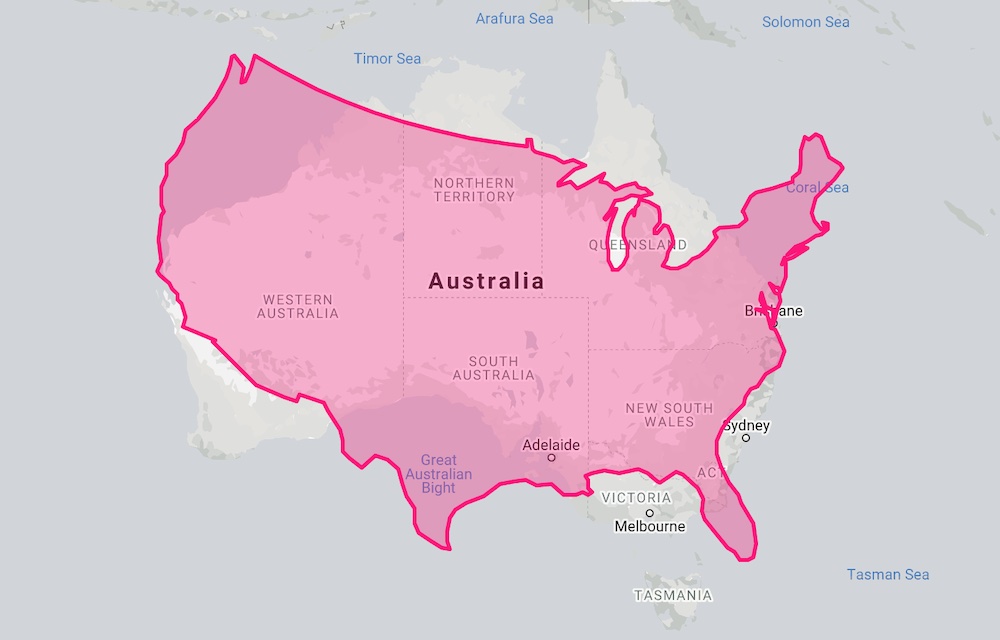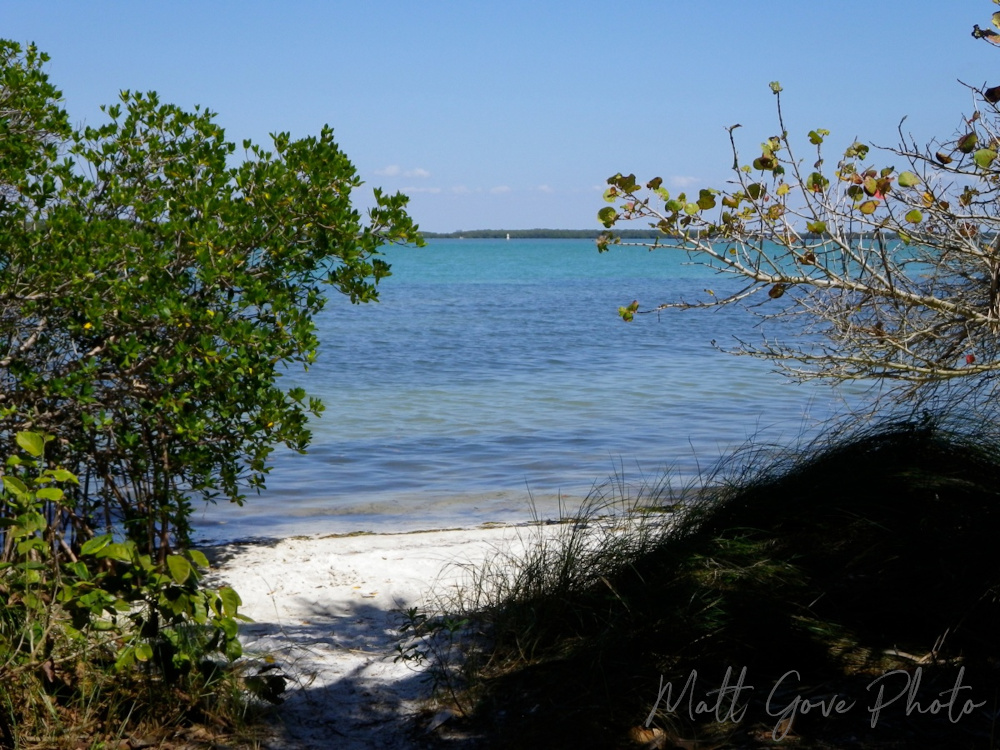When you think of Australia, the first thing that probably comes to mind is The Land Down Under, kangaroos, or koalas. A country that’s well-known for its warm hospitality and top-notch adventures, Australia attracts visitors from all over the world.
As wild as Australia’s frontiers can be, its also has its fair share of crazy geographic oddities. Unfortunately, Australia remains closed to the rest of the world due to the COVID-19 pandemic, so you’ll have to settle for a virtual trip there. Let’s look at some of the more, well, let’s just call it odd side of Australian geography. You may find yourself doing a double-take with some of these, but rest assured, they are all true.
1. Australia is Roughly the Same Size as the United States.
At 2.97 million square miles, Australia would be the world’s largest island. However, it’s hotly debated whether Australia should be considered an island. The mainland United States (excluding Alaska and Hawaii) is slightly larger, at 3.1 million square miles. Here they are overlaid on each other.

2. Australia Only Has 6 States (Plus 3 Internal Territories)
Australia’s states are huge. They’re bigger than most US States and Canadian Provinces. Even Tasmania, Australia’s smallest state, is larger than 12 US States. At 92,000 square kilometers, Tasmania is roughly the same size as Indiana.
Consider Australia’s largest state. At 2.6 million square kilometers, Western Australia takes up the western third of Australia. Just how big is it?
- 1 million square kilometers larger than Alaska
- 4 times the size of Texas
- Half a million square kilometers larger than Nunavut (Canada)
- Over 1 million square kilometers larger than Québec
Fun Fact: Queensland shares the same nickname as Florida. Both states are called The Sunshine State.
3. Contrary to Popular Belief, Sydney is not the Capital of Australia
Sydney is the capital of the State of New South Wales, but it’s not the capital of Australia. Canberra is the capital of Australia. Founded in 1913, Canberra is Australia’s largest inland city and eighth largest city overall.
After the Federation of Australian Colonies was established in 1901, a great debate ensued. Should the capital be established in Sydney or in Melbourne? As a compromise, the capital would be built in New South Wales, as long as it was at least 100 miles (160 km) from Sydney. As a result, Canberra was founded and established as Australia’s capital in 1913.
Fun Fact: In the native Aborigine language, Canberra means “woman’s breasts”. It got its name because the city is cradled between two mountains.
4. Australia is the Only Continent in the World Without an Active Volcano
Of all the things in Australia that can kill you, volcanoes are not one of them. In fact, Australia is surprisingly immune to natural disasters. Other than its infamous bush fires and the occasional cyclone (hurricane), you don’t have to worry about much from Mother Nature. As for the the snakes, spiders, crocodiles, and other poisonous critters running around Australia? That’s a whole different story.
5. Australia has the world’s longest golf course. It measures more than 1,365 km (850 mi) long.
Nope, that’s not a type-o. The Nullarbor Links Golf Course is unlike any in the world. Stretching from Kalgoorlie, Western Australia to Ceduna, South Australia, each participating town or roadhouse along the Eyre highway has its own hole. Each hole features a tee, a green, and a “fairway” made up of natural, rugged Outback terrain.
When you add it all up, the 18-hole par 72 course stretches 1,365 kilometers, or 850 miles.
6. 90% of Australia’s Population Lives Within an Hour of the Coast
In fact, 4 out of every 5 Australians live within 50 km (30 mi) of the coast. The reason? Much of interior Australia is comprised of The Outback, which is a relentless, uninhabitable, and massive desert.
It is not uncommon for Outback temperatures to reach 50°C (122°F) in the summer. Driving across the Outback is not for the faint of heart, but is one of the most satisfying adventures in which you can partake in Australia.
7. The largest cattle station in the world is located in Australia and it’s bigger than Israel
Located in the state of South Australia about 700 km northwest of Adelaide, The Anna Creek Cattle Station is the largest working cattle station in the world. It covers an area of 23,677 km2 (5.85 million acres), or roughly the size of Israel. For comparison, the largest ranch in the United States – the King Ranch in Texas – covers just 3,340 km2 (830,000 acres).
So just how many countries is the Anna Creek Cattle Station larger than? It’s larger than about 45 countries. Here are some of the more notable ones.
| Country | Land Area (km2) |
|---|---|
| Anna Creek Cattle Station | 23,677 |
| Djibouti | 23,180 |
| Belize | 22,806 |
| El Salvador | 20,721 |
| Israel | 20,330 |
| Slovenia | 20,151 |
| Kuwait | 17,818 |
| Qatar | 11,586 |
| Jamaica | 10,831 |
| Lebanon | 10,230 |
8. You can fly from Perth to Melbourne faster than you can fly from one end of Western Australia to the other.
This boils down to distance, with a little assist from the weather. As the crow flies, it’s 2,700 km from Perth to Melbourne. And the distance across Western Australia? Basically the same: 2,650 km.
So why does it take less time to fly the longer distance? Much like the United States, you are much more likely to have westerly tailwinds as you fly eastbound across Australia.
9. If You Visit One New Beach in Australia Every Day, It Would Take Over 32 Years to See Them All
Australia has over 12,000 beaches along its renowned 60,000 km coastline. Visiting 365 beaches a year, it would take 32.8 years to get to 12,000.

10. At 5,614 km (3,488 mi), Australia is Home to the World’s Longest Fence
Stretching across three states through the heart of the Strzelecki desert, it’s an Australian landmark. Since the fence was first built in the early 20th century, it had one job: keep dingoes out of fertile land.
Interestingly, the fence has had a major impact on the environment. Because dingoes eat kangaroos and kangaroos eat grass, there is much less grass on the dingo-less side of the fence. The effect is so stark you can actually see it from space, though it’s not obvious on the satellite images. A recent study showed that after five years, kangaroo-free plots on the dingo-free side of the fence looked like islands of grass in an otherwise barren desert.
To give you an idea of just how long the Australian dingo fence is, my 2019 road trip across Mexico, the US, and Canada, was 5,500 km. As the crow flies, the dingo fence would cover some eye-opening distances.
- Anchorage, Alaska to Guadalajara, Mexico
- Paris, France to Bishkek, Kyrgyzstan
- Cape Town, South Africa to Khartoum, Sudan
- Bangkok, Thailand to Chelyabinsk, Russia
Bonus: The Australian Alps Get More Snow Than the Alps in Europe
I know, you didn’t know the Alps were in Australia, did you? They sit on the border between Victoria and New South Wales in the southeastern corner of Australia. Reaching a maximum elevation of 2,228 meters (7,310 feet), the Alps’ Mt. Kosciuszko mark the highest point in Australia.
The Australian Alps are a mecca for skiing and one of the most underrated spots in the world for winter sports. Because of Australia’s location in the Southern Hemisphere, its peak ski season runs from June to September. Ski buffs routinely make the pilgrimage to take advantage of being able to ski during the Northern Hemisphere summer.
What surprises most people, however, is not so much the fact that it snows in Australia, but rather that the Australian Alps actually get more snow that the Alps in Europe during their respective winters. The reason is simple. The Australian Alps are very close to the coast, while the Swiss and Italian Alps sit quite a ways inland. The ocean is one of the best sources of moisture to dump lots of snow, particularly at high elevations, in the wintertime.
Conclusion
Australia is well known for its rugged terrain, wild frontiers, and extraordinary adventures. From is beautiful beaches to its searing deserts to its Alps, Australia offers something for everyone. Once the world fully reopens from Covid, Australia is certainly on my bucket list. What’s on yours?
Top Photo: Overlook along Scenic Highway 12
Boulder, Utah – June, 2012